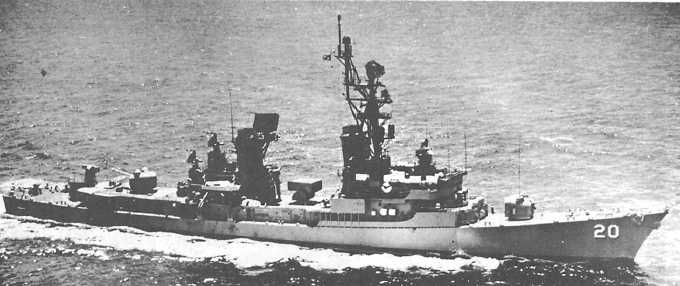| |
launcher for Sea Sparrow missiles, one ASROC
launcher, and two Mk 32 triple-torpedo tubes.
They also have full helicopter facilities to
accommodate the light airborne multipurpose
system (LAMPS). The Spruance-class destroyers
were the first large U.S. warships to use gas-
turbine propulsion. The propulsion system was
selected because of its smaller space requirements,
rapid replacement capability, and cold-start
capability. (The engines can go from “cold iron” to
full power in 12 minutes.)
Guided-missile destroyers (DDGs) of the Coontz
class were formerly designated frigates. They
displace 5,800 tons fully loaded. Each of these
ships has one 5"/54-caliber gun mount, one twin-
Terrier surface-to-air launcher, one ASROC
launcher, and two Mk 32 triple-torpedo tubes.
DDGs of the Charles F. Adams class (fig. 19-6)
are considered excellent multipurpose ships. They
displace 4,500 tons fully loaded. Each ship has one
ASROC launcher, two Mk 32 triple-torpedo tube
mounts, and two 5"/54-caliber gun mounts. Some
of the ships are equipped with one twin- or one
single-Tartar surface-to-air missile launcher. A
few of the ships have one multiple-Chaparral
missile launcher.
FRIGATES. —The U.S. Navy adopted the
classification “frigate” (FF) for ships used for open-
ocean escort and patrol. When they were
developed during World War II, frigates were
classified
as
destroyer
escorts
(Des).
Frigates resemble destroyers in appearance;
but they are slower, have only a single screw, and
carry less armament. FFs have grown in size from
about 1,500 tons displacement to over 4,000 tons,
as in the Knox class (FF-1052). Their armament
varies from class to class. The Oliver Hazard
Perry (FFG-7) class (fig. 19-7.) has a single 76-mm,
62-caliber,
dual-purpose
gun;
a
20-mm
Vulcan/Phalanx rapid-fire gun; a single launcher
for Harpoon missiles; two SH-2H LAMPS
helicopters; and two Mk 32 triple-torpedo tubes.
The Knox class (fig. 19-8) has one Sea Sparrow
missile launcher, one 5"/54-caliber gun, one 20-
mm Vulcan/Phalanx gun, one ASROC launcher,
and four MK 32 fixed torpedo tubes. The Knox
class also has facilities for one SH-2H LAMPS
helicopter.
Submarines
The basic designation SS indicates a submarine
that is a conventional (diesel-powered) ship. The
letter N following the basic designation (SSN)
indicates a submarine with nuclear propulsion.
The letter B (SSB) indicates a submarine with
ballistic missiles and nonnuclear propulsion. The
letters BN (SSBN) indicate a submarine with
ballistic missiles and nuclear propulsion.
The mission of nuclear attack submarines
(SSNs) is to locate and destroy enemy ships and
submarines. They also act as scouts, deliver
supplies and personnel to locations in enemy
territory, and perform rescue missions. Fleet
3.77
Figure 19-6.-Guided-missile destroyer USS Goldsborough (DDG-20) of the Charles F. Adams class.
19-8
|

